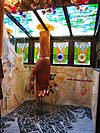Von Jour Caux (梵寿綱, Bon Jukō) is the pseudonym of Toshiro Tanaka (田中 俊郎, Tanaka Toshirō) (born 27 January 1934 in Asakusa, Tokyo), a Japanese architect, artist, and thinker. He has been referred to as the Japanese Gaudi.
Pseudonym
The pseudonym Von Jour Caux combines concepts from ancient Sanskrit texts (Upanishads) and the posthumous name of his adoptive father. More precisely, Brahman is written bon (Von) in Chinese letters, ju (Jour) means "blessed life", and kou (Caux) means "rope", which the architect translates into "a tight rope between blessed life and ultimate reality". Jukou (Ju-Kou) was also his adoptive father's posthumous buddhist name.
Biography
Von Jour Caux studied architecture at the Waseda University and opened an architect firm in 1958.
He travelled to Chicago in 1962, inspired by architects such as Ludwig Mies van der Rohe, and studied painting, sculpture, and arts and crafts at the School of the Art Institute of Chicago, where he met his future wife. In 1971, he abandoned his conventional architectural practice and, along with his wife, formed a group of artists and craftsmen called Art Complex in 1974, the year he adopted the artist pseudonym Von Jour Caux The "Art Complex Movement" is the revival of "Arts and Crafts Movement" in architectural space, such as the use of ornaments, symbolic icons and style.
The group's first project was the Waseda El Dorado (ドラード早稲田 or Shito) in Tokyo built around a "city of gold" utopy. In 1985, he delivered the Mukōdai Home For the Aged erected in Higashiyamato, Tokyo where he focused on the end of life phenomenon taking place in the building. In 1990, he designed the La Porta Izumi apartment building in Tokyo. The building has a distinctive facade of a monumental sculpted body-bent woman with hair falling down cascade-like and mixing with the fire of a torch at the lower levels of the building. In 1992, he designed the aquatic Mind Waa building in Tokyo in collaboration with the building owner.
Style
Von Jour Caux was referred to as the Gaudi of Japan. His work endorse similar shaping logics, but the Japanese architect is rather filled with ideologies from esoteric Buddhism and animism. Antimodernist, his work is more associated to the eclectic catalog of Art Nouveau. Compared to Gaudi, Von Jour Caux gave complete autonomy to his craftsmen, his work truly being the work of the Art Complex Movement.
Waseda El Dorado in TokyoHe also designed the Le bois Hiraki Minamiikebukuro Building in Toshima, Tokyo, and the Tsukada building in Tokyo with a very sober style.
See also
References
- ^ Watanabe, Hiroshi (2001). The architecture of Tōkyō : an architectural history in 571 individual presentations. Edition Axel Menges. ISBN 978-3-930698-93-6. OCLC 606318806. Retrieved 5 September 2011.
- ^ Wada Nahoko, Urban Monuments by Japan’s Gaudí: The Works of Japanese Architect Von Jour Caux, Nippon.com, 5 July 2019
- TOURExplore a unique architect’s buildings, Accesspoint.jp
- "梵寿綱 Von Jour Caux". デジタル版 日本人名大辞典+Plus (in Japanese). Kodansha. on the database of kotobank.jp.
- (in French) Rythms[sic] of Vision, Fgautron.com, 13 september 2007
- Clark Parker, The Top 10 Buildings in Tokyo 建築めぐり 東京, Thetokyofiles.com, 3 February 2015
- Tsukada Building, Fc2.com






